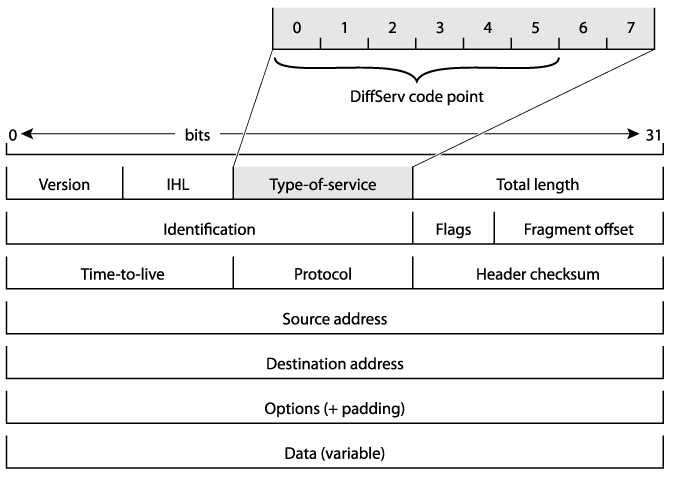DiffServ-based traffic groups forward traffic to egress QoS (Quality of Service) profiles based on the type-of-service (TOS) or traffic class (TC) information in an IP packet. In many systems, this TOS or TC information is replaced with a DiffServ field that uses six of the eight bits for a DSCP (Differentiated Services Code Point), as shown in DiffServe Code Point. (The other two bits are not used.)

Because the DSCP uses six bits, it has 64 possible values (2^6 = 64). By default, the values are grouped and assigned to the default QoS profiles as listed in Default DSCP-to-QoS-Profile Mapping.
Default DSCP-to-QoS-Profile Mapping
| Traffic Group Code Point | SummitStack and Summit Family Switches QoS Profile |
|---|---|
| 0-7 | QP1 |
| 8-15 | QP1 |
| 16-23 | QP1 |
| 24-31 | QP1 |
| 32-39 | QP1 |
| 40-47 | QP1 |
| 48-55 | QP1 |
| 56-63 | QP8 |

Note
The default DiffServ examination mappings apply on ports in more than one virtual router. If you attempt to configure DiffServe examination or replacement on a port that is in more than one virtual router, the system returns the following message:Warning: Port belongs to more than one VR. Port properties related to diff serv and code replacement will not take effect.
You do not need to define these traffic groups. You can enable or disable the use of these traffic groups by enabling or disabling the DiffServ examination feature as described in Configuring a DiffServ-Based Traffic Group. You can also configure which DSCP values map to which queues.

Note
When DiffServ examination is enabled on 1 Gigabit Ethernet ports, 802.1p replacement is enabled and cannot be disabled. The ingress 802.1p value is replaced with the 802.1p value assigned to the egress QoS profile.A related feature is the DiffServ replacement feature, which allows you to configure the software to replace the DSCP in an ingress frame with a different value in the egress frame. For more information on DiffServ replacement, see Configuring 802.1p or DSCP Replacement.

 Print
this page
Print
this page Email this topic
Email this topic Feedback
Feedback